Hi everyone! I’m Matthias Jaggi, a technical staff member of the Snow Physics group of the WSL Institute for Snow and Avalanche Research SLF, and I recently spent a second austral summer at the French-Italian research station Dome C in Antarctica. I set up an experiment with the aim of better understanding how snow metamorphism affects the redistribution of stable water isotopes. But let’s start from the beginning:
The research station is located on an ice sheet over three kilometres thick, of which the top few metres are snow, of course. As the depth increases, the snow compacts into firn and ultimately into ice. Annual precipitation levels of snow are very low here on the East Antarctic Plateau, which means that the lowest metres of the ice sheet are very, very old. The ice sheet therefore provides a perfect record of the climate. It is calculated that the deepest ice brought to the surface by ice core drilling (“Beyond EPICA” project) is around 1.5 million years old. The chemical composition of these ice cores varies according to the drilling depth. We can chart this on a timeline, which allows us to see (very roughly!) which substances or changes in their concentration led to global warm or cold periods. Integrated into climate models, these findings enable us to estimate future climatic changes too. One of these “substances” in the ice cores are the stable water isotopes that occur in different ratios depending on the average temperature of oceans and the atmosphere.
Snow consists of water, and water is a molecule made of hydrogen and oxygen. Accordingly, every snowflake that falls from the sky effectively carries information about average temperature conditions on Earth. However, powder snow does not remain in that form for long as snow is constantly changing. Snow crystals in the snowpack disappear and others re-form. This process is known as metamorphism. As a result, the water isotopes are also redistributed. We want to understand exactly how this happens so that the isotope signals in the ice core can be better interpreted.
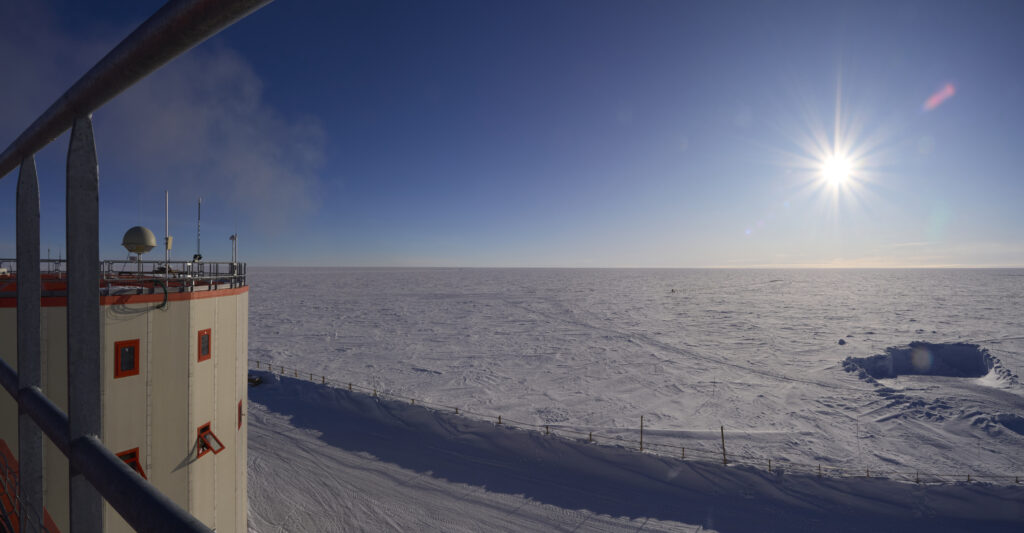
Now, a bit more about the journey. Before leaving New Zealand to Antarctica, I had to reserve time to pick up the pre-ordered polar clothing in Christchurch. But anyway, as oversea flights to Antarctica heavily depend on the weather conditions, my flight could’ve been postponed or cancelled at short notice. So having extra time is, in these cases, unavoidable.
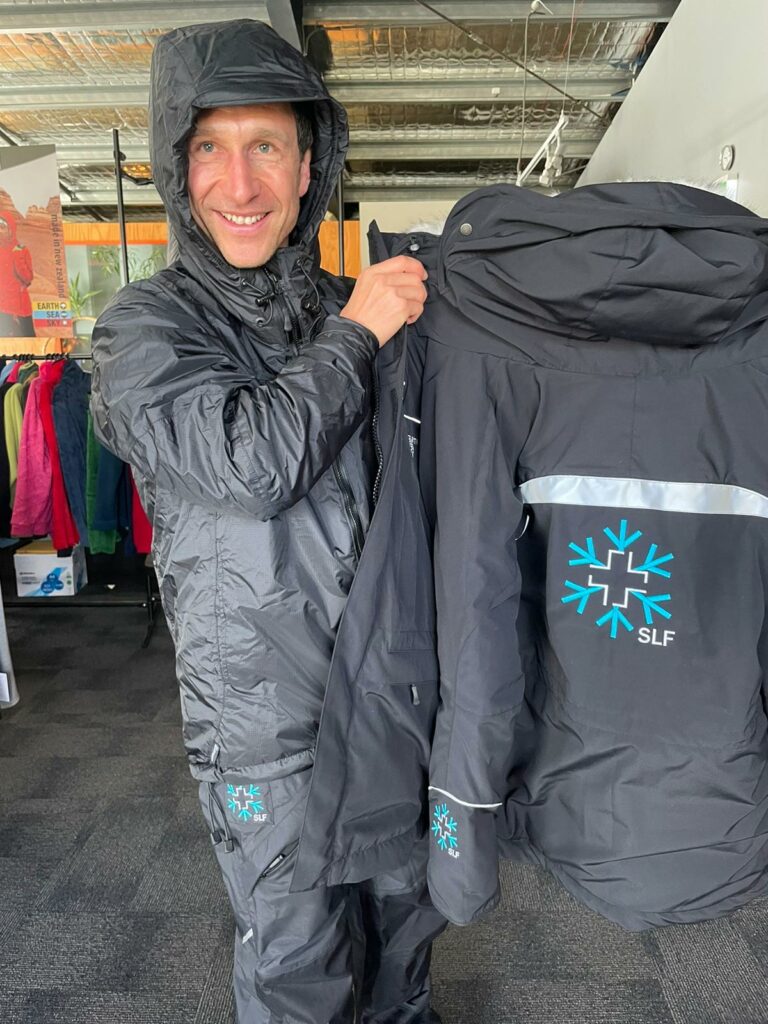
The flight to the Italian Mario Zucchelli Station on the Antarctic coast took almost eight hours, in an Italian military Lockheed C-130 Hercules.

In early summer, when the ice in the Terra Nova Bay in the Ross Sea is still at least two metres thick, the aircraft can land directly on it. The coastal stations are, among other things, a hub and transhipment point for the onward journey into the Antarctic continent. You can spend several days at one of these stations, depending on the weather and the availability of smaller aircraft such as the converted DC-3 (Basler BT-67) or the Twin Otters.
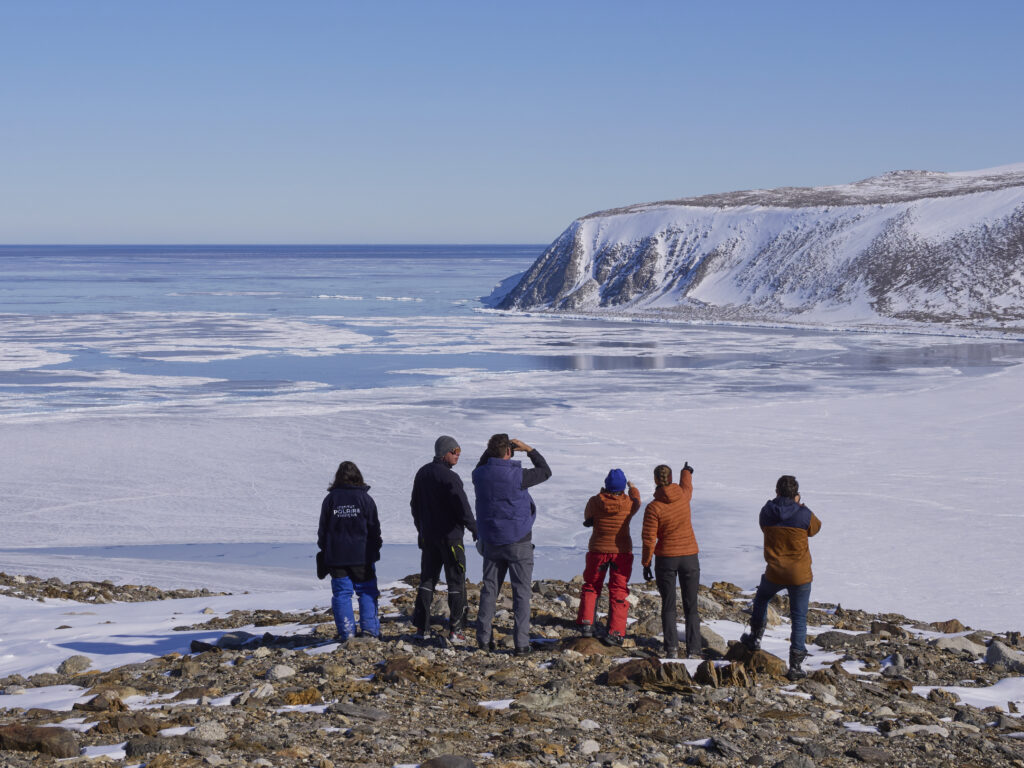
Of course, this also has its advantages as it gives you a chance to explore the surrounding area, within the permitted perimeter. Unfortunately, this time the penguin colonies were off limits due to bird flu, but the hilly, granite-like landscape, the open water far out to sea, the thawing ice belt with its many shades of bluish white, and the glaciers falling into the sea in the background were more than enough to explore. Not forgetting the Italian hospitality and a real portafilter machine for espressos, and even a gelato machine serving gelato cioccolato fondente!
The first flight to Dome C was essentially a cargo flight with an additional six seats for passengers. The group from EPICA, who went to drill the oldest ice, wanted to keep the flights coordinated, so I was fortunate enough to be on the first flight. When we arrived at Dome C, the first thing we had to do was a PCR test for Covid. All negative. Even so, we had different meal times and were billeted in a heated tent next to the main station. Because of the thinner atmosphere over the poles, the altitude of Dome C is equivalent to 4,000 metres in the Alps. That’s enough to give some people altitude sickness – I experienced it the first time – and the combination of altitude sickness and Covid can have serious consequences. The station operators therefore try to keep newcomers somewhat apart from everyone else when they arrive. And sure enough, on the second day of our quarantine, the man in the bed next to mine tested “light positive”, which extended our quarantine period by another three days. The poor guy was then moved to the actual quarantine area, a heated shipping container with a tiny window.
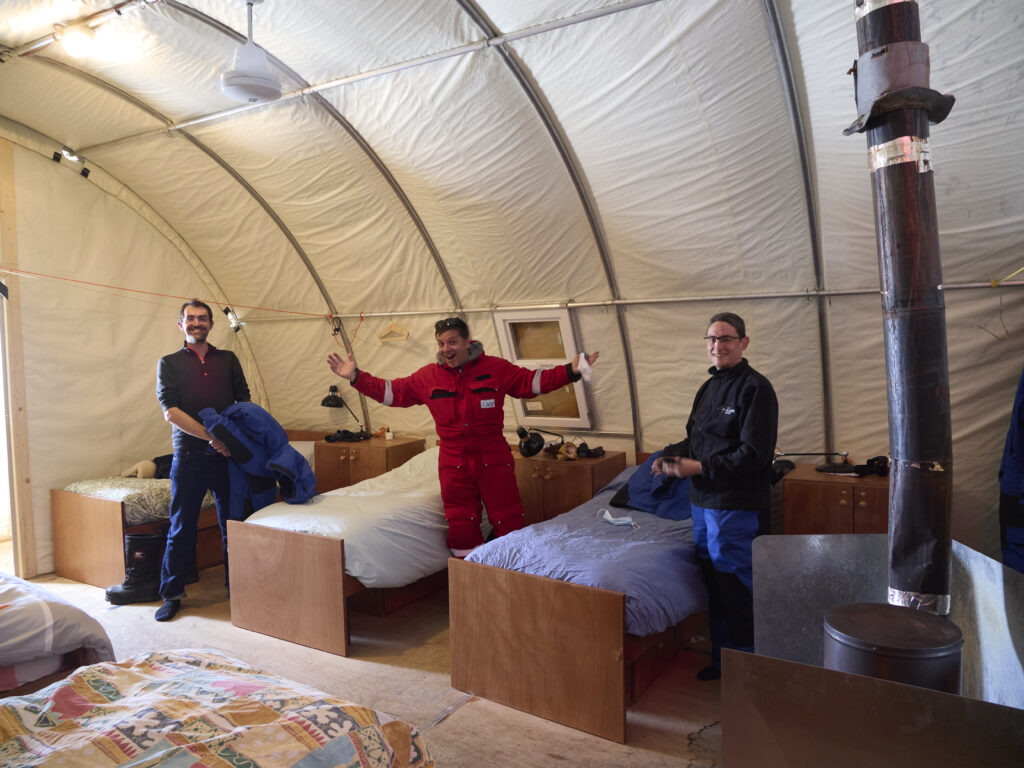
While quarantine was definitely a bit boring, it has the big advantage that I couldn’t overexert myself, which reduced the risk of altitude sickness. After five long days, the Covid PCR batch test was scheduled for the morning. If it was positive, our group of four would remain in quarantine for another three days. If it was negative, it meant that our much anticipated work here at Dome C could get under way. So, you can imagine how overjoyed we were to hear over the radio we were given the all-clear. More days in quarantine would have been tough. Supplies were starting to run low. I couldn’t resist opening the Christmas present I’d been given by my work colleagues in Davos. From the feel, shape and sturdiness, it had to be a book. Sure enough, it turned out to be a crime novel, Bündner Irrlichter, which made my time in quarantine a lot more bearable. Also, the Swiss chocolate I’d brought with me was almost gone. So yes, it was definitely time for change!
On regaining my freedom, the first thing I had to do was work out where everything was. The part of the luggage that was supposed to have arrived was stored somewhere in the tents. With the help of scientific director Vito, I soon managed to track everything down and get it together. This time I was staying in the “Spacca Ossa”, i.e. the “bonebreaker” tent. So far I’d been spared… The tent was divided, and only one part had a stove. That suited me just fine. I stored the instruments in the warm area and for sealing the snow samples later I’d need a temperature of around −5°C anyway. Depending on which part of the tent I was in and how far from the stove I was, I coulc have almost any temperature I wanted – provided I took the position of the sun into account. The “laboratory” workspace was all set, but I also needed an undisturbed test site…

Vito assigned me a spot in the “forbidden area”. This was situated on the side away from the wind (usually) and wasn’t contaminated by soot or other impurities. Also, the location of all activities was precisely logged to ensure that undisturbed snowpack was always available. So a day later I started shovelling, only to suddenly come across cracks at a one-metre depth. Obviously, my first thought was: “they have assigned me a test site like Emmental cheese, full of cracks and small cavities.” But the course of the snow layers around the cracks looked very natural, not at all as if snow had blown in or been shovelled back in. Feeling a little uncertain, I picked up the phone during my lunch break and called my retired ex-boss Martin Schneebeli. I hadn’t quite got to grips with the time difference yet, so he was rather surprised to receive a call in the early morning hours – but hopefully also pleased to hear from me. He explained the phenomenon: when the snowpack cools down to −60°C in winter, the snow loses its plastic flow properties and behaves almost like an ordinary material. It contracts as it cools down, which inevitably results in some cracking. Reassured, I now simply avoid the cracks when profiling.
As mentioned before, we want to understand the influence of snow metamorphism on the redistribution of stable water isotopes. The easiest way to do this is directly on the snow profile itself, of course. This involves measuring both the snow microstructure and the associated isotope concentration at the beginning and at the end of summer, and trying to understand the process based on the changes that have taken place in both.
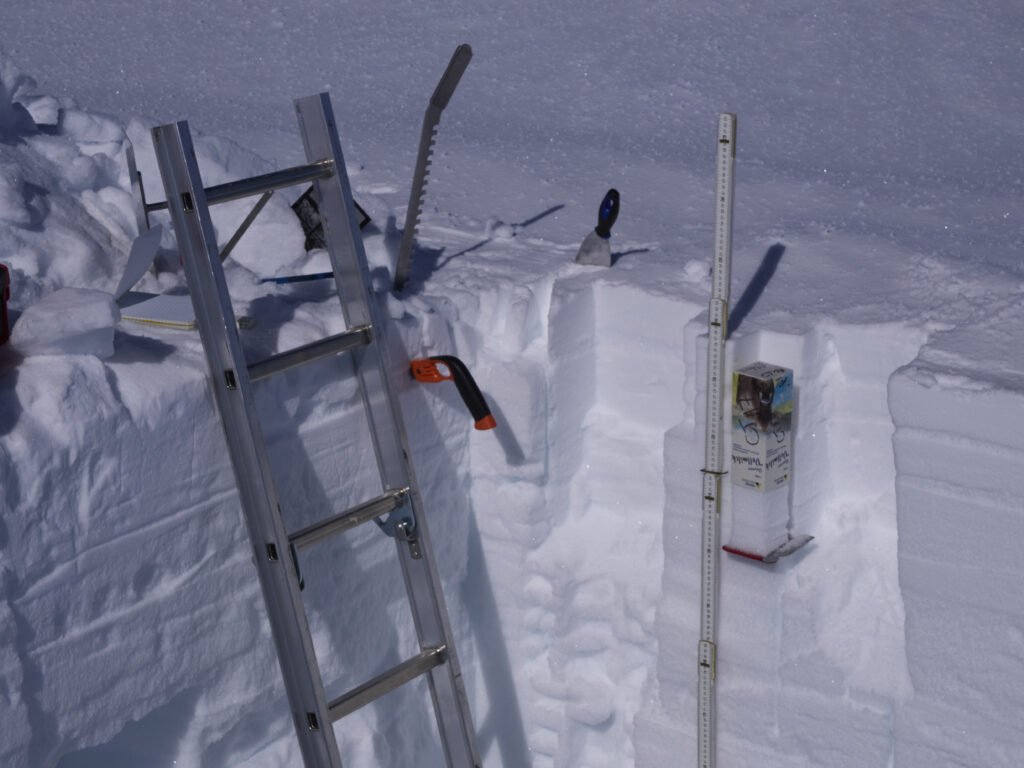
We would be doing that, but to make our lives a little easier, we were also cutting four blocks (40x40x30 cm) out of the profile, packing them airtight in foil and allowing them to “incubate” in metamorphism boxes that we had built ourselves, under simplified but temperature-equivalent conditions. The aim was to try to eliminate processes that could make it harder for us to interpret the experiment and understand what is going on. It’s a twin-track approach, in other words: outside on a real profile with full physical complexity and under simplified conditions in our boxes.
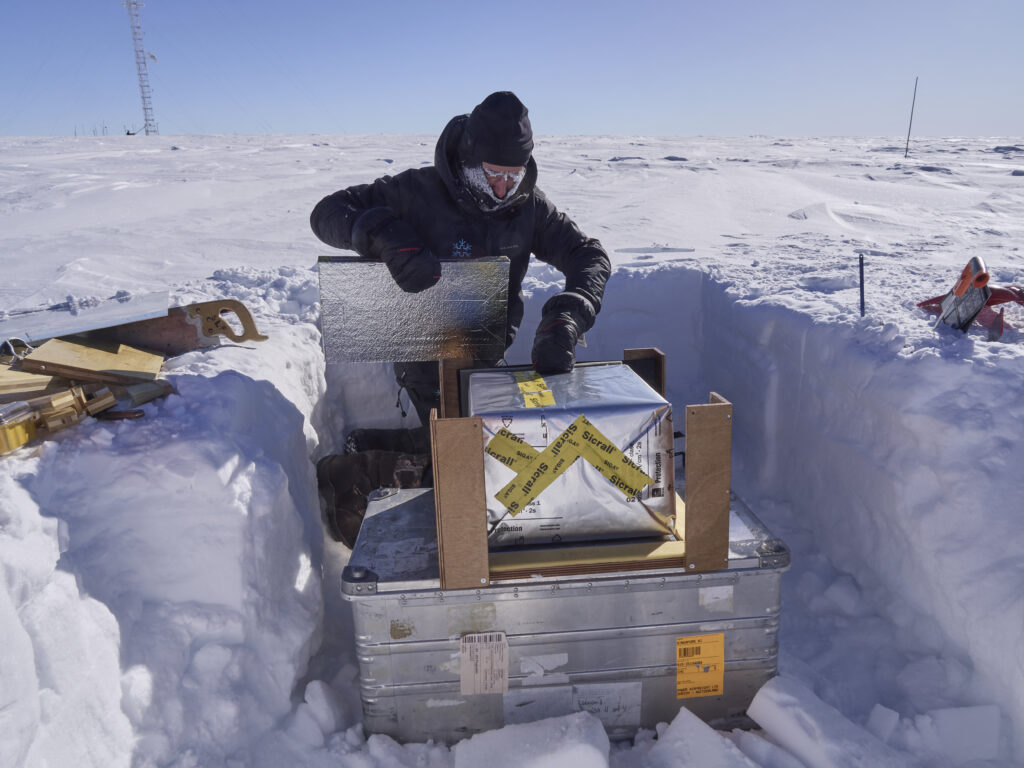
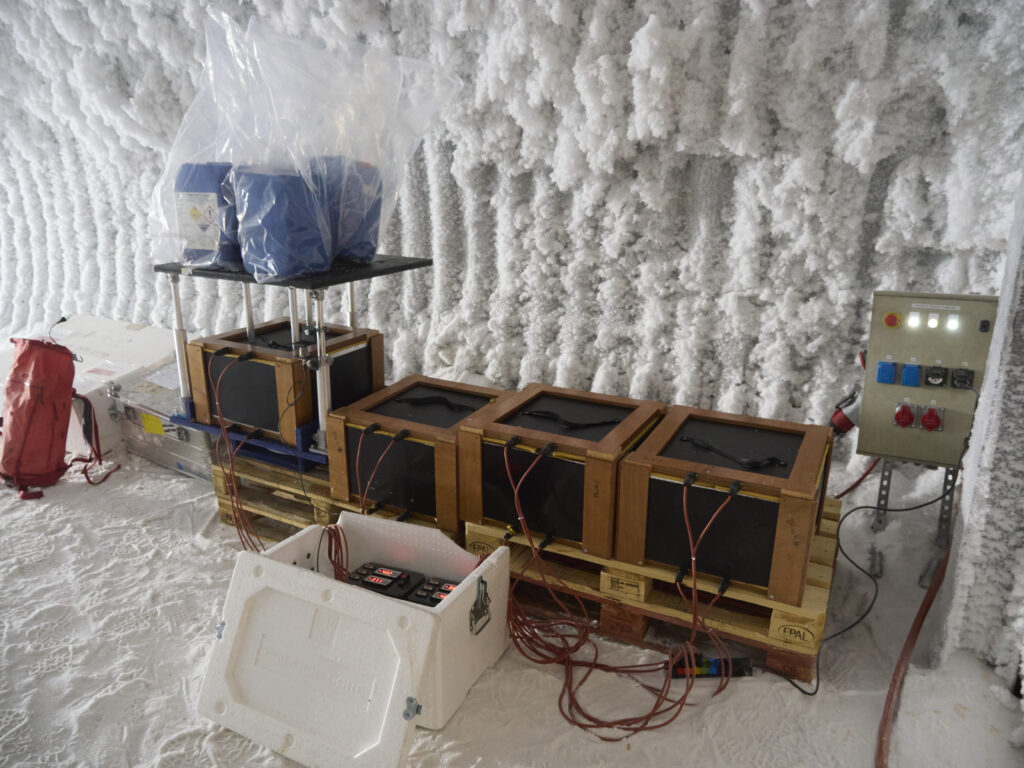
We chose the EPICA facility because it remains at a constant temperature of −50°C. Since the metamorphism boxes can only heat, we need the ambient temperature to be colder than our target temperature. Because snow metamorphism occurs more slowly in Antarctica than in the Alps due to the generally lower temperatures, the aim was to set up the experiment as quickly as possible and only dismantle it shortly before my departure. Apart from the quarantine delay, I think I managed that. Like a cheesemaker checking his wheels, I trudged over to my metamorphism boxes every day and adjusted the temperatures according to the actual conditions in the snow profile.
When the rest of my luggage arrived, I could start to seal the snow samples that had already been taken from the profile and to get them ready for shipping. Sealed snow samples were sent to Davos to analyse their snow microstructure using X-ray tomography.

I’d like to briefly explain why and how we seal snow samples. Imagine packing a snow sample in a box, sticking a stamp on it and sending it halfway around the world. At best, the postman will end up delivering a soggy cardboard box. So that won’t work! Even if you could keep checking to make sure the snow sample remained chilled throughout the journey, experience shows that maintaining perfect refrigeration over a distance of 15,000 kilometres, with transhipment, is something of a pipe dream. Quick side note: even though my hands often freeze like hell while digging a snow profile, snow is physically an extremely hot and therefore changeable material. It’s considered hot because the temperature of the snow material, even here, in one of the coldest regions on Earth, is close to its melting point (“high homologous temperature” is the jargon term). Steel, on the other hand, is far from its melting point at the temperatures usually found on Earth (low homologous temperature) and does not actually change its structure and physical properties.
Affordable refrigerated transport cannot reduce the homologous temperature of snow to such an extent that no microstructural changes would occur. This is where sealing comes in. If we fill the pore space, i.e. the empty space between the snow crystals, we prevent water molecules from sublimating away from the crystal surface, redepositing elsewhere and thus changing the structure. Obviously, the sealing liquid must have a few special properties. For example, it must be just liquid below the freezing point, must not dissolve ice chemically and should then be frozen at –20°C. Sealing preserves the snow microstructure, meaning that even months later we can use a CT scanner to measure what the condition of the snow profile was at the time the sample was taken.
Before dismantling the metamorphism experiment, I also had a prototype instrument, SnowImager, for spatially resolved snow microstructure measurements with me that I was putting through its paces. This device was developed at WSL/SLF together with a local company, Davos Instruments, with financial support from the Swiss Innovation Agency Innosuisse. The remit of Innosuisse is to translate knowledge derived from research, in collaboration with industry, into market-ready applications accessible to a (relatively) wide public. The SLF’s SnowImager will make it possible for the first time to measure a snow profile over a large area in two (three) dimensions. It illuminates a snow profile with near-infrared light and takes images of the reflected light with two cameras. Other methods used up to now essentially involved taking point measurements, which with some effort could be combined to form a one-dimensional profile. In the Alps, where the snow layers are usually fairly horizontal and homogeneous, a vertical, one-dimensional profile already represents the snowpack reasonably well. The SnowImager, however, allows you to measure in two dimensions. Again, some effort of digging a snow profile is required, but by measuring profile after profile, you effectively end up with a three-dimensional spatial structure of the snowpack. Since the Antarctic snowpack is formed less by precipitation and more by wind transport, its layering is very inhomogeneous. In order to correctly interpret the impact of spatially inhomogeneous snowpack layering on the results from the metamorphism experiments, the second and third dimensions are actually essential. Thanks to our industry partner Davos Instruments AG, the SnowImager prototype is already in a very good technical condition, which is not always the case with prototypes. But when you work in windy conditions, in temperatures that feel like –50°C and with cold fingers, you soon find out where the design needs to be tweaked once you get back to your nice warm office. Employing this high-resolution instrument in harsh Antarctic conditions definitely helped improve our understanding of Antarctic snowpack processes.
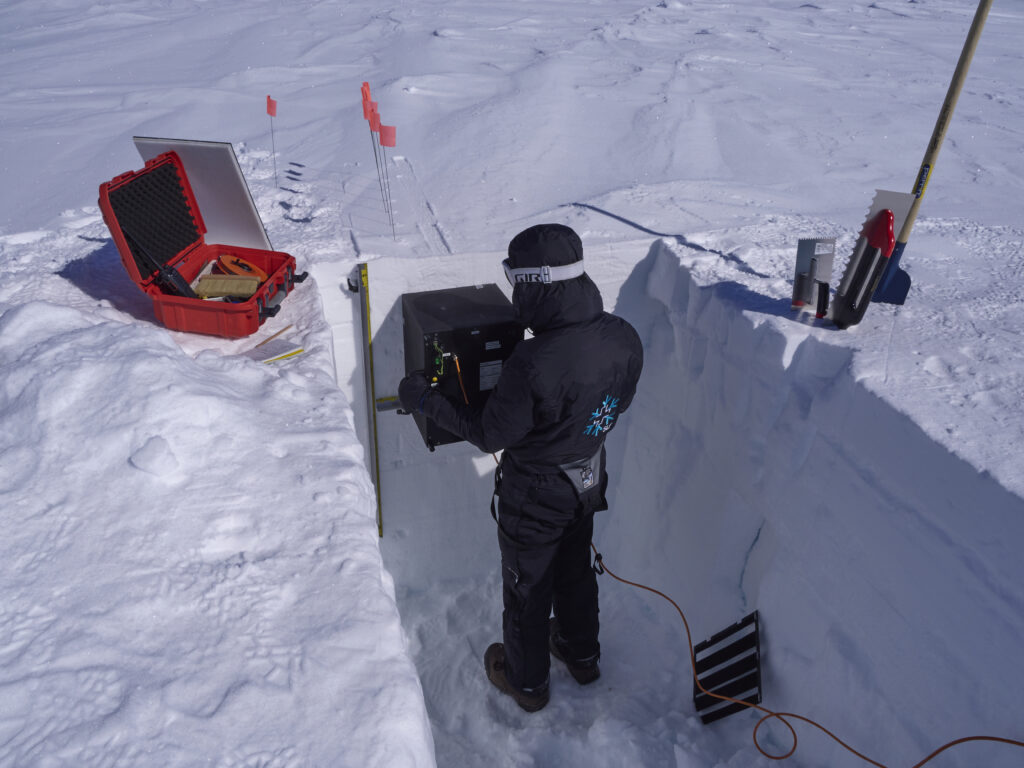
As the expedition was coming to an end, I planned everything meticulously to let the snow metamorphism experiment run as long as possible, but also to be ready and packed on time. This meant that I no longer had any leeway to bring forward or postpone work due to unfavourable weather. And as Murphy’s law would have it, I had to dig my last profile on what was most definitely the worst summer day. For the first time, the sky was completely overcast, there was a fierce wind and it was even snowing a bit (normally it takes a lot of imagination to even recognise precipitation, the so-called diamond dust). However, I was lucky enough to have some help. As I had been working alone in the snow profile 75% of the time, for safety reasons I had to report to the station by radio every half hour. And everyone with a radio, so basically everyone, heard my half-hourly announcements. My name, my voice, my English – all of that must have been etched in their minds. And many people would no doubt have wondered “what’s this guy actually doing out there in the ‘forbidden zone’ every day?” So I kept getting offers from people wanting to help out, which I then, because I’m such a nice person, accepted on the day the weather was terrible. This meant the last snow profile was also completed very quickly.
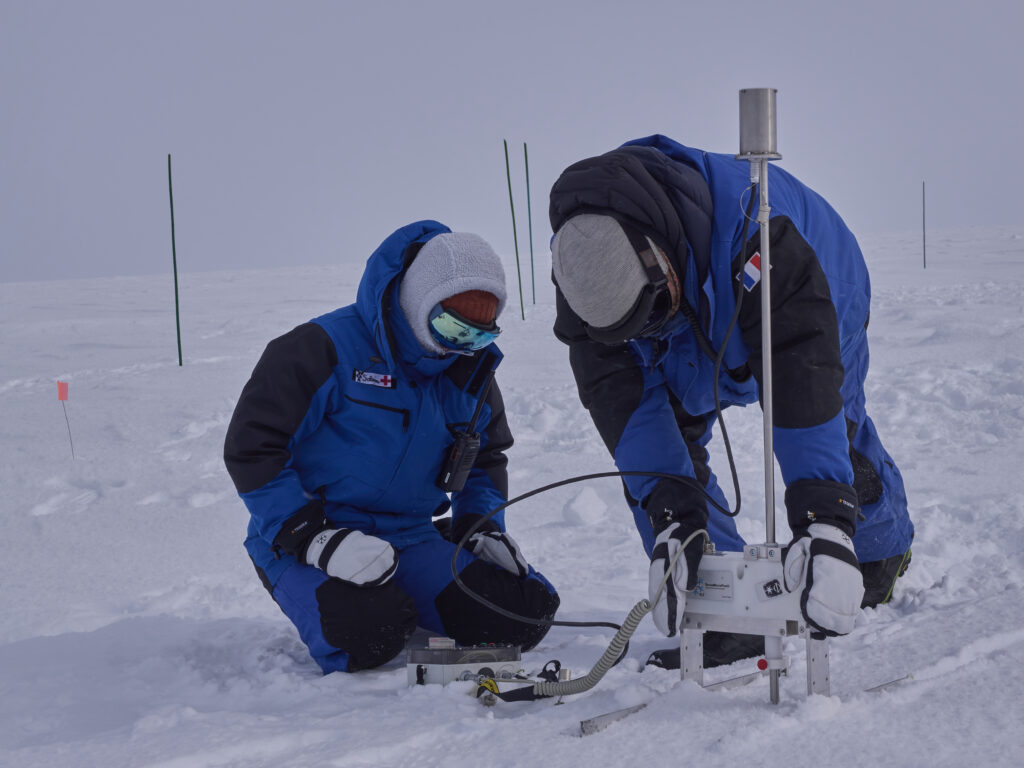
For the final sampling of the four snow blocks in the metamorphism boxes, I was a little tense as I unwrapped them from the foil. “This has to go perfectly.” The blocks were large enough to take a ‘dirty’ sample a second time, but there was not enough for more. First of all, the edges were cut away from the block because we didn’t want samples from areas possibly affected by edge effects. The heating plates of my metamorphism boxes heated evenly over the entire surface and the insulation panels around the block provided good insulation, but there were still heat losses towards the edge and so the conditions there differed slightly from what you are usually aiming for.
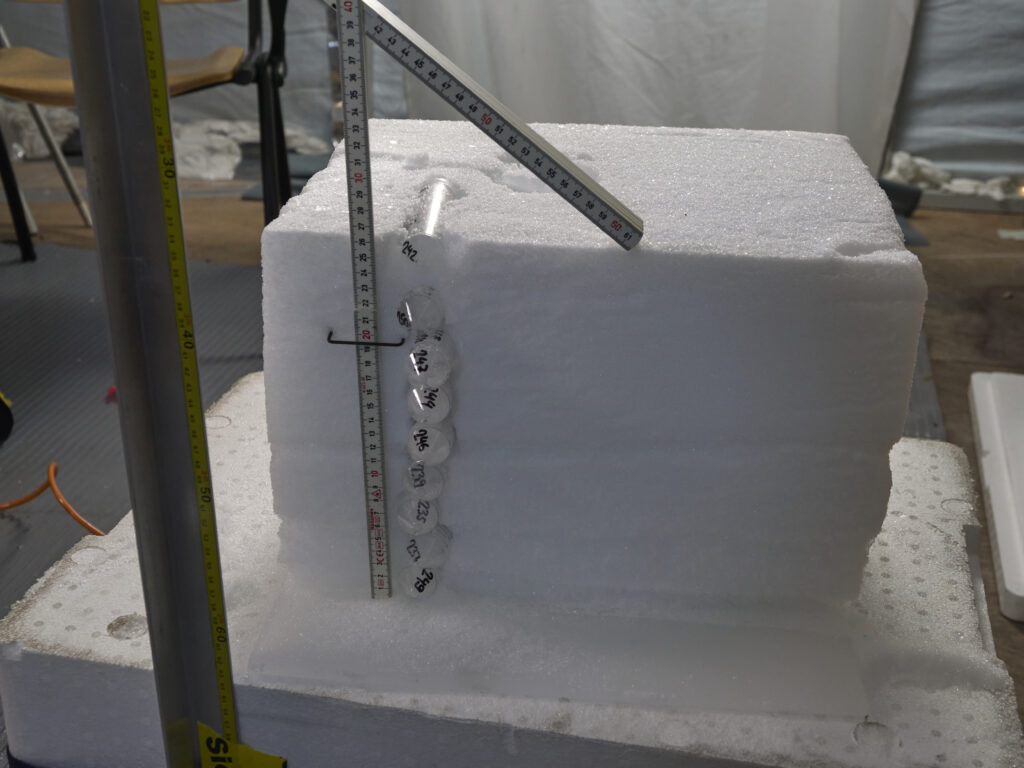
All my samples had to be properly packed, labelled and sealed for the transportation back to Europe. In a cooled-down container, the samples were transported back to Dumont d’Urville by traverse and then by maritime freight to France, arriving in June 2024.
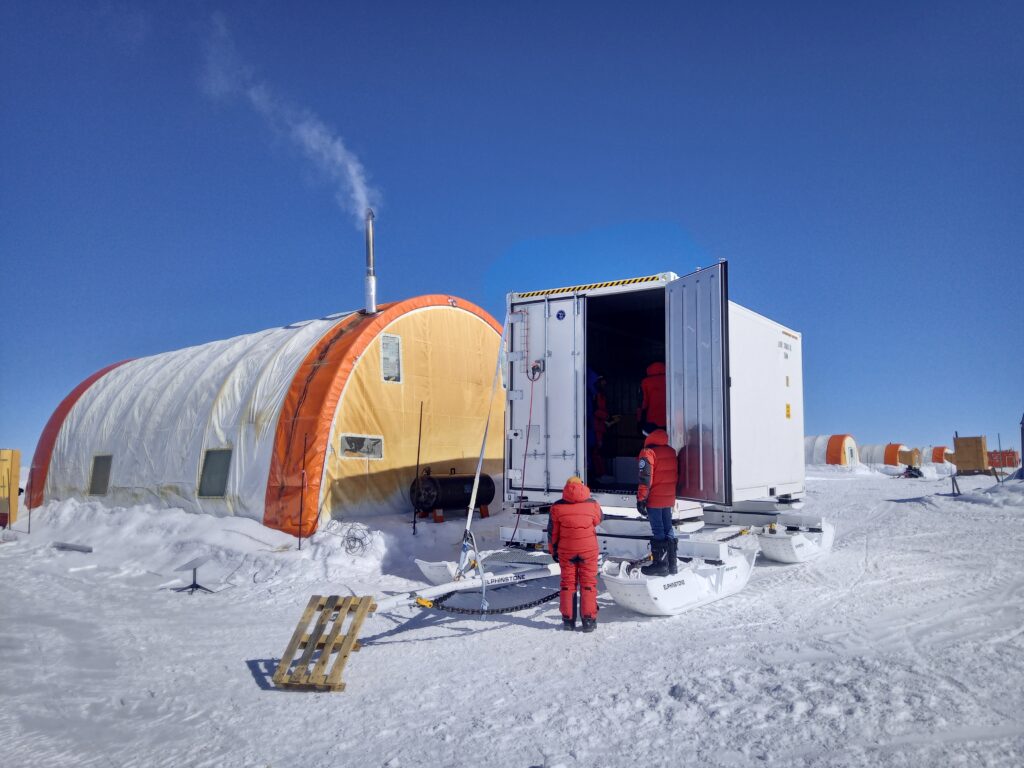
The final step of such an expedition was packing the scientific equipment for the return shipment. And as always, you underestimate how much tidying and packing is involved. I laid out all the equipment next to the boxes for it to dry and I could see whether everything was there. It looked a bit like my childhood bedroom 30 years ago. It was a huge mess, you’re forced to tidy up and don’t really feel like it. In this case, however, I was doing it voluntarily so I was smiling. At the last minute, I stuck the final address label on the last box while my colleagues from logistics were taking the first boxes away. It was a relief to know that the work was done.
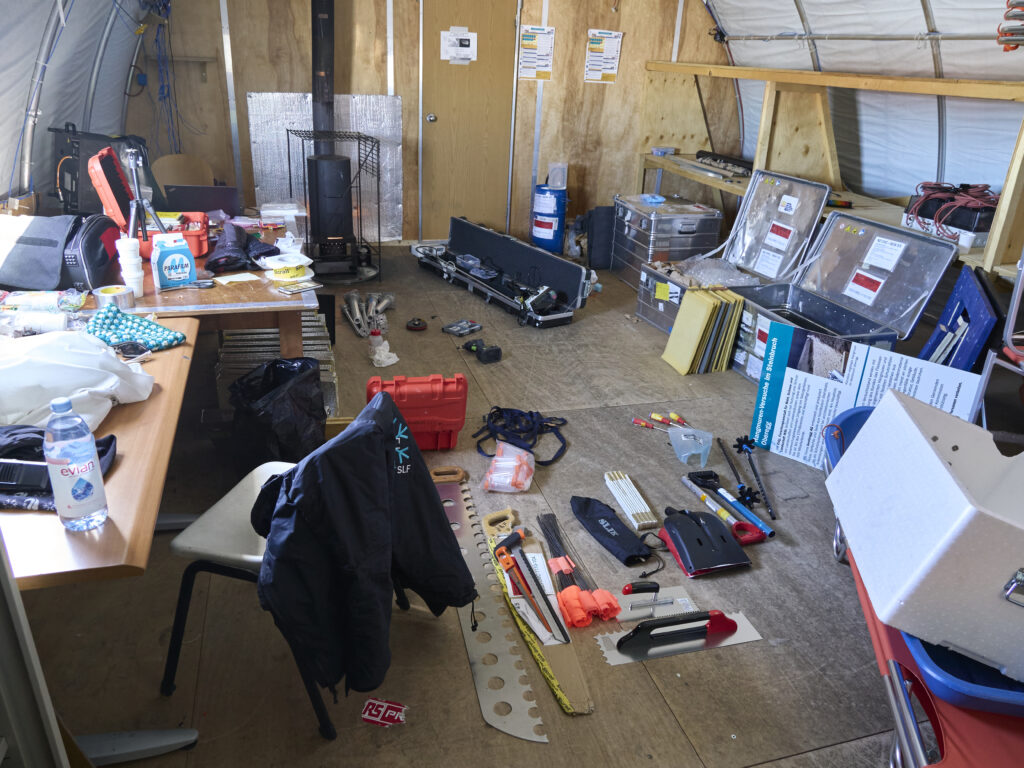
I spent the last few days before my departure from Concordia trying to make myself useful somehow. One day I helped lay cables and install power sockets, on another I and three others made crêpes for the remaining 52 station residents, and I helped the overwintering glaciologist with snow profiling. There is always something to do at a station like this one, so boredom would have been a poor excuse. It also made sense for me personally to give myself a rough daily structure to ease the ‘post-expedition depression’ somewhat. When you’re tired, and your work is done, when you’re planning to go home and the return journey dates change from day to day, none of these factors help lift the mood.
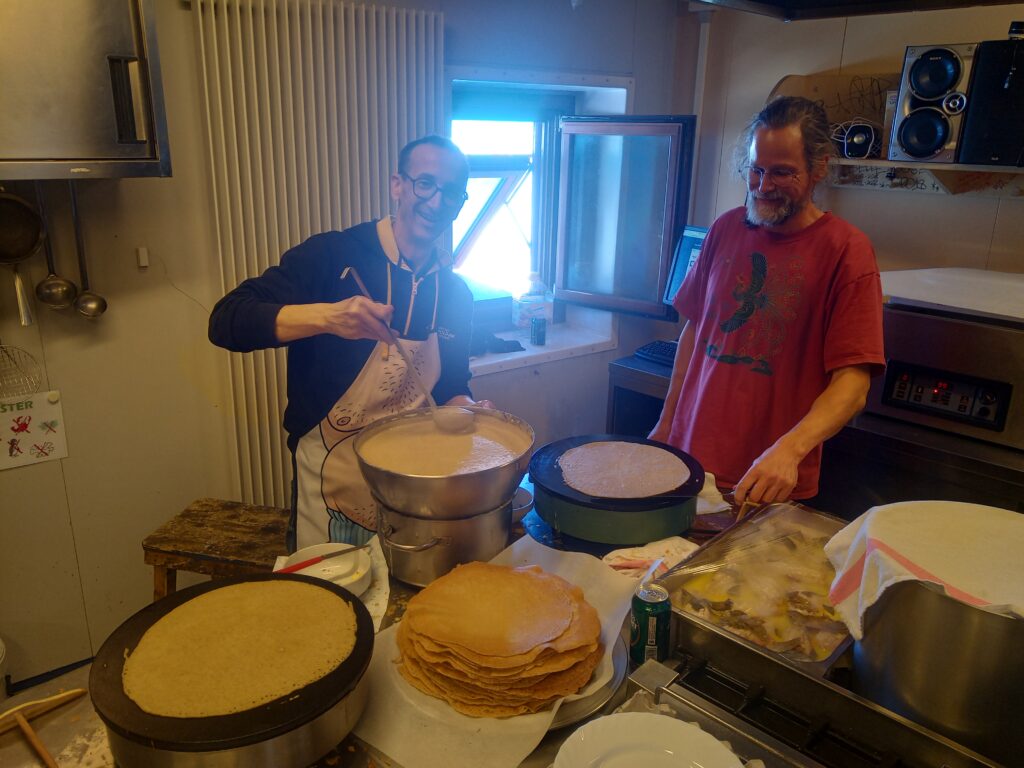
Overall, I consider my 2nd expedition to Dome-C as being scientifically and personally challenging but successful. The instruments and experiments worked well and I was able to collect scientifically very relevant data about the inner-Antarctic snowpack. Personally, I got the chance to experience the landscape of an infinite white plane at one of the remotest places on earth.
We would like to thank the Institut des Géosciences de l’Environnement (IGE), the French Polar Institute Paul-Émile Victor (IPEV) and WSL/SLF for making it possible to travel to Dome-C and conducting the measurements. Furthermore, we would like to thank the Swiss Polar Institute for covering the shipping costs of all the scientific equipment. A special thanks goes to Davos Instruments that built and modified the SnowImager prototype to be suitable for the harsh conditions in Antarctica.
Matthias Jaggi is a technical staff member at the Snow Physics group of the WSL Institute for Snow and Avalanche Research SLF in Davos, Switzerland. His fieldtrip took place during the austral summer 2023-24 with financial support of an SPI Exploratory Grant in the context of the project “The impact of near-surface snow metamorphism on climate signals in Antarctica” led by scientific staff member Benjamin Walter from the WSL Institute for Snow and Avalanche Research SLF.
- Read more about Benjamin Walter’s project